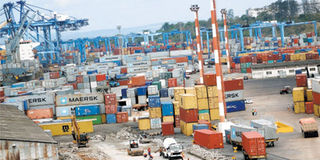Mombasa port loses business as exporters opt for Dar es Salaam

Containers at the port of Mombasa. Delays in cargo clearance have exposed the port to competition from Dar es Salaam . Photo/FILE
What you need to know:
- Kenya is hinging its port business on South Sudan and Uganda, at least in the short term, since its takes longer to haul goods from Tanzania to the twin markets.
Kenya Port Authority (KPA) is losing business to rival Dar es Salaam port as delay in cargo clearance in Mombasa prompts traders from neighbouring countries to turn to Tanzania.
Data from KPA shows that the Mombasa port handled 18.9 per cent less or 552,449 tonnes of cargo from Tanzania, Burundi, Rwanda and the DRC in the nine months to September.
As a result, the port relied on Uganda and South Sudan—that have little choice on their logistic corridor—to grow its export cargo volumes to 3.9 million tonnes in the nine months compared to 3.8 million tonnes in the same period last year.
Shippers attribute the trend to the shorter period it takes to transport cargo from the port of Dar es Salaam compared to Mombasa which is facing congestion that has seen transporters take more than a month to reach Rwanda from three weeks.
“We are losing business to Tanzania because of inefficiency at the port,” said Gerald Kagumo, the vice chairman of East Africa Freight Forwarders Association.
With the reform going on there (Tanzania), Kenya is going to lose even more business, said Mr Kagumo. Tanzania Port Authority has announced a $1.4 billion (Sh120 billion) upgrade with its eye on South Sudan, Uganda, Rwanda and Burundi—which are also key target markets for the Kenya port, also on the expansion trail.
Eastern Africa is witnessing increased trade with the establishment of the common market—which allows for free movement of goods, capital and people in a market of 130 million people.
This has seen logistics firms such as port operators angle themselves for new business, prompting Kenya and Tanzania to announce plans to establish new ports in Lamu and Tanga respectively.
But the loss of business to Tanzania is set to hit the earnings of KPA, logistic firms like transporters and clearing and forwarding agents.
Kenya is hinging its port business on South Sudan and Uganda, at least in the short term, since its takes longer to haul goods from Tanzania to the twin markets.
For instance, the road between Mombasa and Kampala measures 1,170 kilometres compared the route through central Tanzania, estimated at 1,500 kilometres.
Cargo to and from South Sudan rose 48.3 per cent to 249,571 tonnes in the nine months to September from 168,287 tonnes in the same period last year.
This saw its share of cargo business at KPA increase by two percentage points to 6.4 per cent—making it the fastest growing market. As investors take interest in South Sudan and the world’s newest nation race for alternative logistic corridor to avoid hostility from Khartoum, it’s expected that its share will move to the double digit zone.
Alternative route
Uganda share of export cargo at KPA stood at three million tonnes or 78.8 per cent of the export volumes—making it a key market for the Mombasa port.
But Kampala has stepped up the search for alternative routes through Tanzania following the near cut-off of the country from its trade partners by the mayhem that followed Kenya’s disputed 2007 presidential election.
President Yoweri Museveni has stepped up negotiations with Tanzania for an alternative railway passage connecting the port of Tanga to Uganda despite the higher transport costs.
Cargo destined to Rwanda dropped 27.5 per cent to 162,995 tonnes in the period under review while DRC’s fell 17.1 per cent to 262,846 tonnes in the same period. Those to Burundi fell 74.6 per cent to 1,375 tonnes.
This article first appeared in the Businessdailyafrica.com




